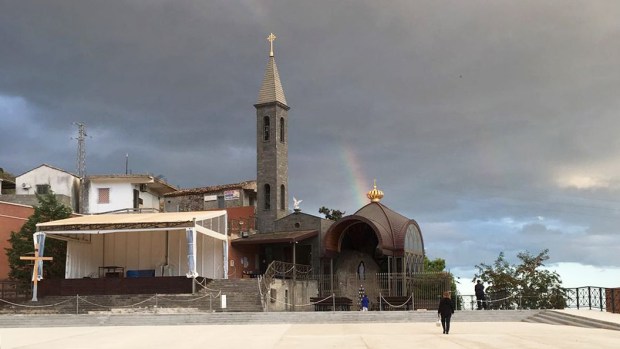Lenten Campaign 2025
This content is free of charge, as are all our articles.
Support us with a donation that is tax-deductible and enable us to continue to reach millions of readers.
The Dicastery for the Doctrine of the Faith (DDF) has authorized the devotion linked to the Italian shrine of the "Madonna dello Scoglio" — Our Lady of the Rock — located in Santa Domenica di Placanica, southern Italy. The Calabrian diocese of Locri-Gerace made the announcement on July 16, 2024.
In less than a month, this is the fourth case of apparitions on which the dicastery has officially pronounced itself, since the new norms for investigating supernatural phenomena came into force.
In a letter dated July 5 and ratified by Pope Francis, Cardinal Víctor Manuel Fernández, prefect of the DDF, confirms the nihil obstat pronounced by Bishop Francesco Oliva, the head of the Diocese of Locri-Gerace, in which the shrine is located. The Catholic faithful are therefore authorized to make pilgrimages to the shrine and hold spiritual events there.
The origin of the shrine
Devotion to Our Lady of the Rock was born on the spot where the Virgin Mary is said to have appeared in 1968; she asked an 18-year-old peasant boy, Cosimo Fragomeni, to have a chapel built in her honor. The former bishop of Locri-Gerace officially recognized this devotion in 2008.
The current bishop promoted the chapel, which was attracting numerous pilgrims, to the status of "diocesan shrine" in 2016. Cosimo Fragomeni joined the Franciscan Third Order and now leads the life of a hermit.

In line with the new norms issued on May 17 for the study of supernatural phenomena in the Catholic Church — apparitions, revelations, etc. — Bishop Francesco Oliva has asked the DDF to give its opinion. According to these norms, it’s up to the former “Holy Office” to give final approval after the diocesan investigation.
The DDF agrees with the bishop's "positive report.”
"No critical or risky elements have emerged [...]. Instead, there are signs of grace and spiritual conversion," notes the prefect. Rome's nihil obstat does not, however, declare "whether the events relating to the spiritual experience in question were supernatural or not.” Nor does it imply "any judgment — either positive or negative — on the lives of the persons involved in this case," the letter states.
Caution and vigilance are essential
The dicastery recommends that the bishop exercise "constant vigilance so that there may be no manipulation of persons, undue financial gain, or serious doctrinal errors that could cause scandal, harm the faithful, or undermine the credibility of the Church."
A decree published on the diocesan website allows the faithful to adhere to the devotion of Our Lady of the Rock "with caution," specifying that they "are not obliged to believe in it." Supernatural phenomena, even those recognized by the Church and universally popular, such as Lourdes and Fatima, are not matters of dogma in the Church.
In recent times, the DDF has issued numerous official statements on alleged apparition sites. On June 27, for example, it declared the "apparitions of Trevignano Romano" on the outskirts of Rome to be a mystical fraud. On July 8, it authorized the promotion of the Italian Marian apparitions known as the "Mystical Rose of Fontanelle" or "Madonna of Montechiari." And on July 11, it declared that the “Lady of All Nations" Marian apparitions were not of supernatural origin.











